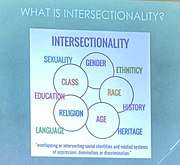BaCCC/Module 5/Introduction
Module 5: Intersectionality: What Can We Learn from Others?
Introduction
Context
You have perhaps heard about the push for diversity, equity and inclusion (or DEI), especially in the workplace (see, e.g., Ideal 2023), but you might not be familiar with the concept of intersectionality.
This module will help you look at climate change and responses to it from the perspectives of different people, often living in the same community, who have very different social identities and positions in society. It will introduce you to intersectionality and the justification for keeping intersectionality in mind when looking at different people’s lived experiences of climate change and different responses to it.
You will then peel back the layers of why some people and populations are more vulnerable to the impacts of climate change than others. Why are they being hit first and worst?
Finally, you will look at how people-centred knowledge and wisdom can help reduce the adverse impacts of climate change. During or following (or, hopefully, before) a climate-induced disaster, we can learn from one another how to better adapt and build resilience to climate change.
In this module, some of the case studies shared are from the South Asian region. This is because South Asian countries are highly susceptible to climate change disasters, partly due to their geophysical location, land characteristics, etc. Ironically though, the climate is changing due to excessive carbon emissions by the industrialised countries, but the adverse impacts of climate change fall disproportionately on the people in this and other vulnerable regions.
Learning Approach
Module 5 is divided into three lessons:
Lesson 1: What Is Intersectionality?
Lesson 2: Different Lived Experiences of Climate Change and Responses to It
Lesson 3: What Can We Learn From Others?
All the lessons have in-text activities that are meant to help you understand important climate change concepts and enable you to interact with the lesson. You are advised to do these exercises before proceeding to the next lesson, as they will help you check to see if you really understand what you have read. Intersectionality is not the easiest of concepts to grasp; so let’s get started. This module might feel like a mini film festival! This is so that you can see and hear the intersectional impacts of climate change on people around the world.
(You can adjust the playback speed and/or turn on subtitles/captions.)
H5P Object Parameters
The H5P parameters below will be replaced by the actual H5P object when it's rendered on the WordPress site to which it's been snapshotted.


